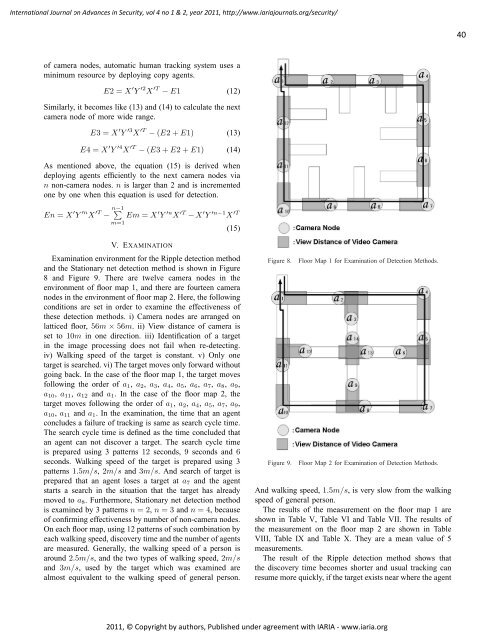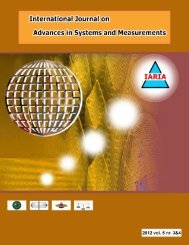Fault Tolerance Framework using Model-Based - IARIA Journals
Fault Tolerance Framework using Model-Based - IARIA Journals
Fault Tolerance Framework using Model-Based - IARIA Journals
Create successful ePaper yourself
Turn your PDF publications into a flip-book with our unique Google optimized e-Paper software.
International Journal on Advances in Security, vol 4 no 1 & 2, year 2011, http://www.iariajournals.org/security/<br />
of camera nodes, automatic human tracking system uses a<br />
minimum resource by deploying copy agents.<br />
E2 = X ′ Y ′2 X ′T − E1 (12)<br />
Similarly, it becomes like (13) and (14) to calculate the next<br />
camera node of more wide range.<br />
E3 = X ′ Y ′3 X ′T − (E2 + E1) (13)<br />
E4 = X ′ Y ′4 X ′T − (E3 + E2 + E1) (14)<br />
As mentioned above, the equation (15) is derived when<br />
deploying agents efficiently to the next camera nodes via<br />
n non-camera nodes. n is larger than 2 and is incremented<br />
one by one when this equation is used for detection.<br />
En = X ′ Y ′n X ′T − n−1 ∑<br />
Em = X<br />
m=1<br />
′ Y ′nX ′T − X ′ Y ′n−1X ′T<br />
V. EXAMINATION<br />
(15)<br />
Examination environment for the Ripple detection method<br />
and the Stationary net detection method is shown in Figure<br />
8 and Figure 9. There are twelve camera nodes in the<br />
environment of floor map 1, and there are fourteen camera<br />
nodes in the environment of floor map 2. Here, the following<br />
conditions are set in order to examine the effectiveness of<br />
these detection methods. i) Camera nodes are arranged on<br />
latticed floor, 56m × 56m. ii) View distance of camera is<br />
set to 10m in one direction. iii) Identification of a target<br />
in the image processing does not fail when re-detecting.<br />
iv) Walking speed of the target is constant. v) Only one<br />
target is searched. vi) The target moves only forward without<br />
going back. In the case of the floor map 1, the target moves<br />
following the order of a1, a2, a3, a4, a5, a6, a7, a8, a9,<br />
a10, a11, a12 and a1. In the case of the floor map 2, the<br />
target moves following the order of a1, a2, a4, a5, a7, a9,<br />
a10, a11 and a1. In the examination, the time that an agent<br />
concludes a failure of tracking is same as search cycle time.<br />
The search cycle time is defined as the time concluded that<br />
an agent can not discover a target. The search cycle time<br />
is prepared <strong>using</strong> 3 patterns 12 seconds, 9 seconds and 6<br />
seconds. Walking speed of the target is prepared <strong>using</strong> 3<br />
patterns 1.5m/s, 2m/s and 3m/s. And search of target is<br />
prepared that an agent loses a target at a7 and the agent<br />
starts a search in the situation that the target has already<br />
moved to a8. Furthermore, Stationary net detection method<br />
is examined by 3 patterns n = 2, n = 3 and n = 4, because<br />
of confirming effectiveness by number of non-camera nodes.<br />
On each floor map, <strong>using</strong> 12 patterns of such combination by<br />
each walking speed, discovery time and the number of agents<br />
are measured. Generally, the walking speed of a person is<br />
around 2.5m/s, and the two types of walking speed, 2m/s<br />
and 3m/s, used by the target which was examined are<br />
almost equivalent to the walking speed of general person.<br />
Figure 8. Floor Map 1 for Examination of Detection Methods.<br />
Figure 9. Floor Map 2 for Examination of Detection Methods.<br />
And walking speed, 1.5m/s, is very slow from the walking<br />
speed of general person.<br />
The results of the measurement on the floor map 1 are<br />
shown in Table V, Table VI and Table VII. The results of<br />
the measurement on the floor map 2 are shown in Table<br />
VIII, Table IX and Table X. They are a mean value of 5<br />
measurements.<br />
The result of the Ripple detection method shows that<br />
the discovery time becomes shorter and usual tracking can<br />
resume more quickly, if the target exists near where the agent<br />
2011, © Copyright by authors, Published under agreement with <strong>IARIA</strong> - www.iaria.org<br />
40







